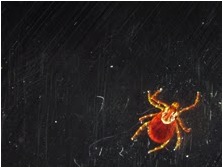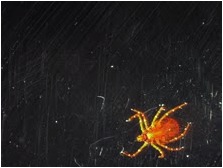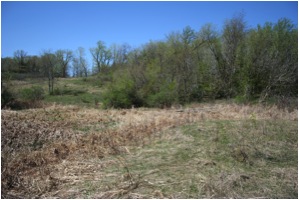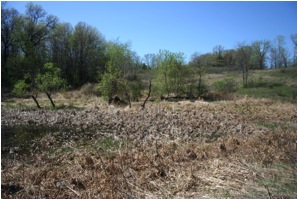Wood Tick
Contact
Katharine Ordway Natural History Study Area9550 Inver Grove Trail Inver Grove Heights, MN 55076 651-455-6204 (On Site)
651-696-6230 (On Campus)
andersonm@macalester.edu
Biotic Inventory: Documenting Diversity at the Katharine Ordway Natural History Study Area
Documenting Diversity at the Katharine Ordway Natural History Study Area
Dermacentor variabilis: The Common Wood Tick


Figure 1-Dorsal View Figure 2- Ventral View
Taxonomy
Kingdom: Animalia
Phylum: Arthropoda
Class: Arachnida
Order: Acarina
Suborder: Parasitiformes
Superfamily: Ixodoidea
Family: Ixodidae
Genus: Dermacentor
Species: variabilis
Common names: The Common Wood Tick, American Dog Tick
Diagnostic Characteristics
Ticks are members of the class Arachnida, but they are placed into the subclass Acarina, which containes ticks and mites, because they have very distinct characteristics that set them apart from the rest of the class. Rather than having their body divided into a cephalothorax and an abdomen (the regular chelicerate body plan), it is divided into two different parts, an idiosoma and a gnathosoma. The idiosoma bears the four pairs of legs, a pair of eyes, and is the elastic receptacle for the consumed blood. In hard ticks, like the wood tick, the dorsal idiosoma is coverd by a hard, inelastic dorsal shield called the scutum. In females the scutum only covers a small portion of the anterior idiosoma, allowing the female to become distended when engorged with blood. Conversely, in males the scutum covers the entire idiosoma preventing the male from engorging itself; only females can grossly distend their idiosoma. The posterior portion of the idiosoma is composed of eleven rectangular scallops called festoons. The anus, only present in adults, is located on the ventral, medial idiosoma. The gnathosoma bears the mouth parts of the tick and is located anterior to the idiosoma.
Adult male and female Dermacentor variabilis ticks, wood ticks, are generally reddish-brown to brown in color with silvery grey markings on their scutum. The scutum of a female wood tick is mostly reddish-brown, but is surrounded by a grey, u-shaped border. The scutum of a male is covered in grey and reddish-brown stripes. Non-engorged females are typically 5 mm long, whereas males are typically 3.5 mm long regardless if they’ve been feeding or not. An engorged female can reach up to 15 mm long and 10 mm wide5,3. The collected specimen (figures 1 and 2) is a non-engorged female of the species D. variabilis.
Ecology
Adult wood ticks are typically active from mid-April to early September, larvae are active from March through July, and nymphs are active from June to early September. They prefer environments such as overgrown urban and rural lots, wood-lined creeks, abandoned farm fields and lots, weedy/grassy roadsides, and edges of hiking trails. High light intensity and low humidity stimulate tick activity.
Ticks climb up low lying grasses or other vegetation and lie in wait for a suitable host to brush against its perch. They clasp onto the vegetation with their third legs and keep the other legs outstretched in order to grasp a passing host. This behavior is known as questing. Ticks are not able to jump or fly, only crawl, so they require direct contact with a host in order to parasitize it. Also, contrary to popular belief, ticks do not quest from great heights, like those of trees; they only quest from low-lying vegetation. If ticks are found high up on a host, the tick has climbed to that point from low on the host’s leg2,3. The specimen from Ordway was collected in a grassy prairie surrounding a pond. The specimen was found crawling up the leg of a host (me).
Life Cycle
The life of a tick is composed of 4 different developmental stages: the egg stage, the 6-legged larva, the 8-legged nymph, and, finally, the adult stage. The cycle requires a blood meal for transformation from larva to nymph, nymph to adult and by the adult to produce eggs. The cycle also requires three different hosts, and takes anywhere from 54 days to two years to complete depending on environmental conditions and host availability. The lengths of tick development stages are heavily dependent upon environmental conditions and host availability.
An adult female D. variabilis feeds on its host from five to 14 days before it is ready to drop off its host and digest the blood meal. After it drops off, the engorged female takes roughly one week to digest the large blood meal and to develop her clutch of eggs. Any given female can lay anywhere from 4,000 to 6,500 eggs. The eggs are laid directly on the ground and will hatch 26 to 40 days later.
After hatching, larvae immediately begin to climb very low growing vegetation and begin questing for their first blood meal. If conditions are right, larvae can live up to 11 months without feeding. Their preferred hosts are small mammals, such as mice or shrews. Larvae will spend two to 14 days feeding on its host. Once feeding is complete, larvae drop off their host in order to digest their blood meal. During digestion they begin a transformation into the nymph stage. At the end of digestion and transformation, about a week later, the larva will molt into the nymph stage.
The nymph begins questing for its second host, a slightly larger mammal, such as a raccoon or opossum. Nymphs are able to survive for six months without feeding. Once attached to a host, the nymph will feed for three to ten days then drop off the host, digest, and molt into the adult stage. The entire process can take anywhere from three weeks to several months.
Adults feed on larger mammals still, usually dogs, deer, cattle or even humans. Adult ticks can live for up to two years without a blood meal. The female tick will engorge herself with the blood of its host for up to 13 days. Mating is done on the host as well. After the feeding period, it drops off the host, lays eggs, and the cycle begins again with a new generation. After laying its eggs, the female tick dies, completing its life cycle3.
Distribution
Dermacentor variabilis is widely distributed across the United States and Canada. Population is highest in the eastern United States, ranging from Massachusetts to Florida. There are also populations located in the central U.S (Minnesota and surrounding states), California (west of the Cascades and Sierra Nevada Ranges), and east of Saskatchewan in Canada3.
Voucher Information
This specimen was collected from a grassy prairie surrounding a pond at the Katherine Ordway Natural History Study Area in Inver Grove Heights, MN. The area was very bright, not shady and the grass was very dry. The specimen was preserved in ethanol.


References
- Illinois Department of Public Health. 2003. http://www.idph.state.il.us/envhealth/pccommonticks.htm.
- University of Florida Entomology and Nematology Department. 2009. http://entomology.ifas.ufl.edu/fasulo/vector/chapter_05.htm.
- 3. University of Florida Institute of Food and Agricultural Sciences. 2008. http://entnemdept.ufl.edu/creatures/urban/medical/american_dog_tick.htm.
- 4. Rhode Island Department of Health. 2010. http://www.health.ri.gov/disease/communicable/lyme/dogtick.php.
- 5. Lander University. 2007. http://webs.lander.edu/rsfox/invertebrates/dermacentor.html.
Compiled by Joel Soma.
Biodiversity & Evolution (BIOL 270) Professr Sarah Boyer.Spring 2010
Specimen collected at Macalester College’s Katharine Ordway Natural History Study Area on April 15, 2010